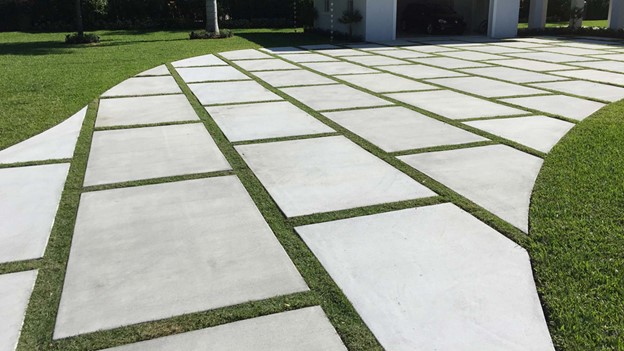Concrete slabs are one of the most versatile construction materials available and can be used for a variety of projects. It’s all thanks to its varied forms.
From driveways and patios to walls and benches, concrete slabs provide strong support for any project.

Here are 10 different types and uses for concrete slabs you may not have known about.
Uses of Concrete Slabs
You can enjoy this versatile material in any of the following areas.
1. Patios
Concrete slabs are great for patios or other outdoor living spaces. Concrete slabs are an ideal material for patios as they provide a solid foundation that won’t sink or shift over time. Plus, its maintenance is painless.
2. Driveways
Concrete slabs are also commonly used for driveways and other paved areas around the home or business as they offer superior strength and durability against heavy vehicles, weather, and foot traffic.
3. Walkways
Whether you want to add a path through your garden or construct a walkway around the perimeter of your property, concrete slabs are an excellent choice. They provide a solid foundation that won’t crack or crumble over time, plus they look great!
4. Retaining Walls
Retaining walls are often constructed using concrete blocks but can also be built using concrete slabs for better stability. The slabs provide a more secure foundation than blocks, ensuring the wall stays upright even with heavy rains or erosion issues in the area.
5. Benches
Concrete benches are becoming increasingly popular indoors and outdoors due to their sleek design and durability against weather conditions such as rain and snowfall.
6. Fire Pits
Many people choose to build fire pits with concrete (over wood or stone) due to their strength and durability against high temperatures.
7. Steps & Staircases
Concrete is an excellent choice for staircases as it provides superior stability compared to other building materials like wood or bricks.
8. Garden Edging & Borders
You may use various materials like stones, bricks, or wood for garden edging, but nothing beats good old-fashioned concrete when it comes to providing extra stability.
9. Pool Surrounds
Pool surrounds made from concrete give off a modern vibe while being able to withstand all kinds of weather conditions.
10. Fountains & Water Features
Fountains, waterfalls, ponds etc., can add charm & beauty to any outdoor space, so why not consider constructing yours out of durable yet stylish precast concrete?
Once you have laid out concrete slabs in your desired area, you may also hire a provider of concrete grinding in Geelong for a more finished look.
Types of Concrete Slabs
Now that we know how diverse the use of concrete slabs can be, let’s learn about the types of slabs.
1. Precast Concrete Slabs
Precast slabs are cured in manufacturing plants and then transported to the job site for installation. The most notable benefit of slab preparation in production facilities is the improvement in efficiency and tighter quality control that may not be possible on location.
2. Composite Concrete Slabs
It is typically made of reinforced concrete poured over profiled steel decking. During the building phase, the decking serves as a working surface and formwork. It also serves as an external reinforcement during the slab’s service life.
3. Concrete Slabs on Grade
These are also termed floating slabs. You prepare these slabs by pouring concrete directly on the ground rather than on a prepared surface. There are again 3 types of this—ground slab, stiffened raft slab, and waffle raft slab.
4. Bubble Deck Concrete Slabs
To build this, you start by first inserting prefabricated plastic bubbles, followed by inserting reinforcement between and on top of the plastic bubbles. Then you pour new concrete. The middle part of the slab is now filled with plastic bubbles in place of the concrete.
5. Hollow Core Concrete Slabs
It is a specific kind of precast slab that is used for running cores. These cores serve as service ducts in addition to reducing slab self-weight and improving structural efficiency. It is appropriate in situations when quick builds are sought.
6. One-way Concrete Slabs on Beams
One-way slabs on beams are built using the cast-in-situ method, which entails attaching forms, installing reinforcements, and then pouring brand-new concrete.
7. Two-way Concrete Slabs on Beams
Building this type of slab is similar to a one-way slab on beams, but additional formwork may be necessary because two-way slabs need support on all sides. The beams make the slabs stiffer, resulting in very little deflection.
8. Flat Concrete Slabs
It is often a reinforced slab supported directly by columns or caps without the usage of beams. This kind of slab needs minimum formwork as it is the columns that take on the loads directly.
9. Grid Concrete Slabs
Another name for these slabs is Waffle slabs. This particular slab of reinforced concrete has square grids with deep sides. Form-fixing, pod placement on shuttering, reinforcement installation, steel mesh installation, and concrete pouring are all steps in the building of a Grid slab.
10. Ribbed Concrete Slabs
It is a floor slab typically 50 to 100 mm thick and is supported by ribs of reinforced concrete (or joists). The ribs are regularly placed at intervals of no more than 750mm and are typically tapered. Girders resting on columns provide support for the
Conclusion
As you can see, there is no shortage of uses when it comes to precast concrete—neither a shortage of types.
Whether it’s constructing steps, fire pits, benches, fountains etc., these versatile building materials will help bring life into any home/business environment in no time!
So don’t hesitate to pick up some concrete today & get busy creating something beautiful! To make efficient use of this distinguished construction material, you must find a reliable and experienced concrete contractor.
You can Google for concrete contractors. We recommend checking out Excon—one of the best providers of concrete grinding & polishing in Geelong.

